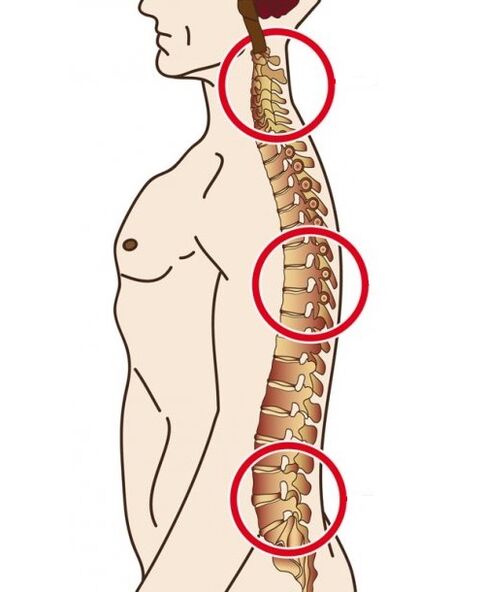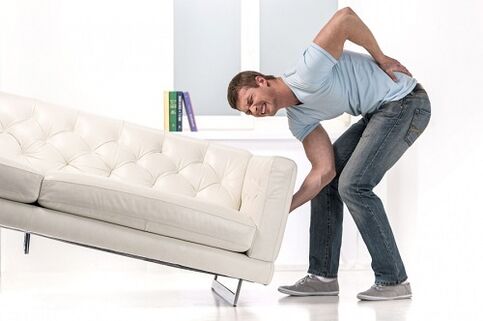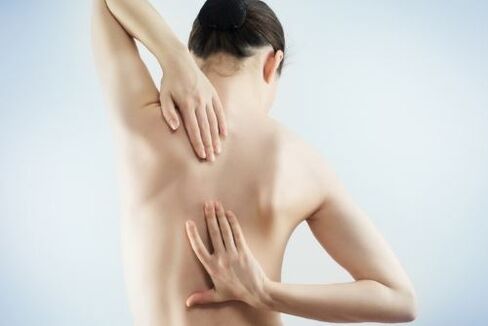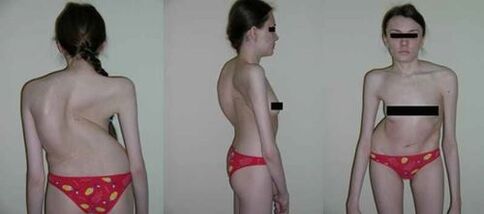What is this disease, osteochondrosis?The definition of the disease can be described as a degenerative lesion of cartilage in the intervertebral discs with further spread on the bone.The causes of osteochondrosis are completely diverse, but mostly they become injuries, a motionless lifestyle, in one position.However, osteochondrosis is not excluded for nervous reasons.
The insidence of the disease is that it can occur in every part of the motor system of the human body and its provocateur can be neurosis.People have different forms of osteochondrosis of the spine.In general, this term is common in medicine to mean a number of dystrophic degenerative processes that are localized in the intervertebral discs between the spine and the vertebrae.
Osteochondrosis: What is it?Types of osteochondrosis
What is osteochondrosis?- In medicine, the following types of osteochondrosis are differentiated:
- cervical;
- thoracic;
- Lumbar spine.

The name of the disease depends on the localization of pathological processes.
Basically, osteochondrosis is sized among people of advanced age.In recent decades, however, incidence has been increasingly found in humans at a young age.
Why does osteochondrosis appear in Young?This is mainly due to the fact that children do not receive proper physical training.The causes of osteochondrosis can also be explained by an excess body weight, which is often observed in young people.Statistics say that today every eighth person has back diseases.
A big problem is that many children sit on the computer all the time and play inpatient video games.In addition, many professions are associated with sedentary work today.And this affects the attitude without exception, weakens the muscles, which leads to other negative consequences.In fact, a lifestyle limited in movements and physical activity is a direct way to back diseases.
How manifests osteochondrosis?
There are such unique ones who claim that there is no osteochondrosis.At the same time, it is worth understanding that such a pathology is associated with a violation of the trophism of the intervertebral discs, which inevitably leads to a deformation of the fabric.This fact cannot be denied in any way.It is therefore obvious nonsense to ignore the disease and to say even more that it does not exist.
What is osteochondrosis?This is when discs lose their mobility due to degeneration.At the same time, the gaps between the vertebrae are reduced, and this segment begins to lose stability, appears from osteochondrosis.A change in the distance between the vertebrae provokes the nerve end.This influences the tension of the back muscles.Later pain appears against the background whose neurosis occurs.
Changes in dystrophic nature in slices with osteochondrosis weaken the outer fibrous ring.In this regard, patients can appear in protrusions and hernia.In addition, the destructive progress of the disease goes into the joints, between vertebral bands, which leads to the formation of bone growth on the vertebrae.
Osteochondrosis can help the patient have difficulties when the body is ended, which is associated with the loss of elasticity of the spine.Here there is an vertebrae and pathological deformations of affected areas in the spine.All of this means that a person develops chronic osteochondrosis.

Erosive osteochondrosis
Sometimes patients have a rapidly processing form of damage to the intervertebral discs determined by erosive osteochondrosis.This form of the disease is characterized by much more pronounced symptoms, while the patient often has suspected spondylodiscit.The main criterion for the diagnosis of identifying an erosive osteochondrosis is the preservation of sclerated terminal plates, which can only be followed with an X -Ray or a CT.
Osteochondrosis: symptoms and causal connection
For the following reasons, the osteochondrosis of the spine appears:
- excessive loads on the spine;
- Obesity;
- Hard physical work;
- Sedentary or standing work;
- Use of unpleasant shoes;
- improper attitude;
- a motionless lifestyle;
- genetic and acquired deformations in the spine;
- flat feet;
- genetic predisposition;
- Metabolic disorders;
- Poisoning of the body;
- nervous overload;
- stressful situations;
- serious somatic diseases;
- hormonal violations;
- Autoimmune diseases;
- Transfer injuries to the spine;
- a diet with a lack of minerals and vitamins;
- Having harmful to health;
- The use of unpleasant sleep accessories for night's sleep.

It is impossible not to say that professional athletes can also be exposed to increased loads of the spine, which can of course lead to the development of back diseases.In addition, you should not restrict the number of your training, since the risk of osteochondrosis during this period is the largest.
In essence, osteochondrosis is a wonderful disease.Patients constantly feel the periods of worsening the disease and remission.An increase in physical exertion, overload and hypothermia can lead to intensive pain.
When we talk about the lesions of the cervical spine, it is worth noting that patients have pain in the neck, upper limbs that may be accompanied by stiffness in movements, deafness of fingers and headaches.Pink of the vertebral artery can be observed, which leads to an increase in blood pressure, a lack of oxygen absorption on the brain.
With thoracic osteochondrosis, the patient can feel painful or on the contrary, acute pain that can be expressed as an intermediate lodent "on the back".Pain syndrome can be felt in the heart and in the lungs and in other organs.A patient can also have difficulty breathing.In addition, a bad and difficult Rooster syndrome described on the right is sometimes diagnosed.
The gastalgic shape of the osteochondrosis of the Brustregion is accompanied by heart syndrome when the patient feels stiffness in the chest, lungs and heart.In this case, pain syndrome can increase during deep breathing.With the further development of the Gastalgic syndrome, the pain in the stomach area moves associated with the development of gastritis.

With osteochondrosis of the lumbar region, pain occurs most frequently in the lower back, in the sacrum and in the lower extremities.Duil feelings can be intense in movement, shots in the back and deafness of the legs are possible.Disruptions in the functions of the genitarian system are not excluded.
Among other things, the patient can have a dysplastic osteochondrosis of the lumbar spine.This form of the disease is accompanied by the formation of growth on the vertebrae together with pathological deformations of the spine.
In patients with osteochondrosis of the lumbar region, the so -called visceral syndrome can be observed.At the same time, the pain in the affected area gives the internal organs, and a person can think that the kidneys are violated, for example.
What does polyseggmentary mean osteochondrosis?
In a pathology that has been observed immediately in several segments or covers the entire spine, polysic osteochondrosis is diagnosed in the patient.The affected segments can be placed directly near the other or by one or even in certain sections of the spine.Of course, in such a situation, comprehensive special treatment is required, which not only has to take tablets, but also physiotherapeutic methods.
Osteochondrosis and the causes of the disease of a polysic type type are a much more serious disease than it may seem at first glance.If no adequate treatment is carried out, this state can lead to a complete immobility of the back.The next photo shows how serious osteochondrosis can be.

Osteochondrosis and vegetative-vascular dystonia (VSD)
Pathological degenerative processes can still exist for some time and make progress until a person is completely lost, the opportunity to move.So if you find at least one sign of osteochondrosis, go to the hospital immediately.
Since pathological deformations in intervertebral discs are often accompanied by irritation of vegetative nodes, the disease can cause neurosis and a variety of disorders in the work of the cardiovascular system.In fact, one of these episodes is vegeto-vascular dystonia.
The main features of the VVD are:
- Unexpected print jumping;
- Pain in the head;
- Nausea with vomiting;
- Insomnia;
- Dyspnea;
- Sweat;
- A constant feeling of revision.
Sometimes a person can lose consciousness in a severe form of VSD.
The occurrence of the symptoms mentioned above can be a result of damage to the spine, but also impair an impairment of the functions of the endocrine and somatic systems.Therefore, only a specialist can make the right diagnosis and select the correct treatment according to the relevant examinations.
Treatment of osteochondrosis
The treatment of degenerative processes in the back always implies a very long course of therapy, which is based on the integrated use of various drug medication and physiotherapeutic interventions.If you have neurosis with osteochondrosis, be sure to contact a neurologist.The selection of optimal techniques and medicines is only possible after a complete examination of the patient and various studies.
The doctor can prescribe a restrictive diet, the implementation of physiotherapy exercises, sometimes it is appropriate to apply folk methods.However, all measures should only be taken taking into account the actual state of the patient, the presence of complications and simultaneous diseases such as neurosis, VSD, increased blood pressure, etc.
One of the main conditions for the successful treatment of osteochondrosis is a sequence.With a tightening of the disease, you naturally have to remove the first thing you have to remove for pain syndrome.In addition, the work should be carried out to suspend the destructive processes.

When treating osteochondrosis, physiotherapy exercises, massage (including self -massage), manual therapy, acupuncture, hydrotherapy and the like are used.With regard to the use of drugs, your main effect should aim to remove pain, restore the cartilage, and the normalization of the bloodstream in areas affected by the disease.
Most of the time, patients are prescribed:
- Medicines with analgesic effect (anti -inflammatory non -steroid drugs);
- Muscle relaxants;
- Means of local anesthesia (compression, blockade, patch and the like);
- Chondroprotectors;
- Complexes of vitamins and minerals;
- vasodilating drugs;
- Medicines for the normalization of metabolic processes in tissues.
Media science education for osteochondrosis plays an extraordinary role.The training specially selected for a specific patient helps him to strengthen the muscles in the back, and enables you to form a muscle corset to ensure a uniform distribution of the loads on the back.Due to the constant training, the blood flow to the intermediate discs improves.One person will straighten the attitude and make their spine mobile.
There is also a special complex of breathing exercises with which you can alleviate muscle spasms and pain syndrome.It is pretty good to deal with swimming - it is able to unload the spine as far as possible.

When carrying out training therapy, it is important to use special simulators for rehabilitation.It is worth noting that physical activity is contraindicated during the worsening of the disease.In the remission period, however, you need to add drug therapy.
Prevention of osteochondrosis
To prevent the occurrence of osteochondrosis, a person should first maximize the daily load on the back.For this they need:
- Choose comfortable shoes with high quality for socks;
- Avoid a long stay in an unpleasant position, a seated or standing position;
- Monitor your weight;
- Control posture;
- Do not increase unnecessarily excessive severity;
- Receive load to strengthen the spine muscles.
Osteochondrosis is an illness that has very serious consequences.And absolutely everything about osteochondrosis is impossible to know.



























